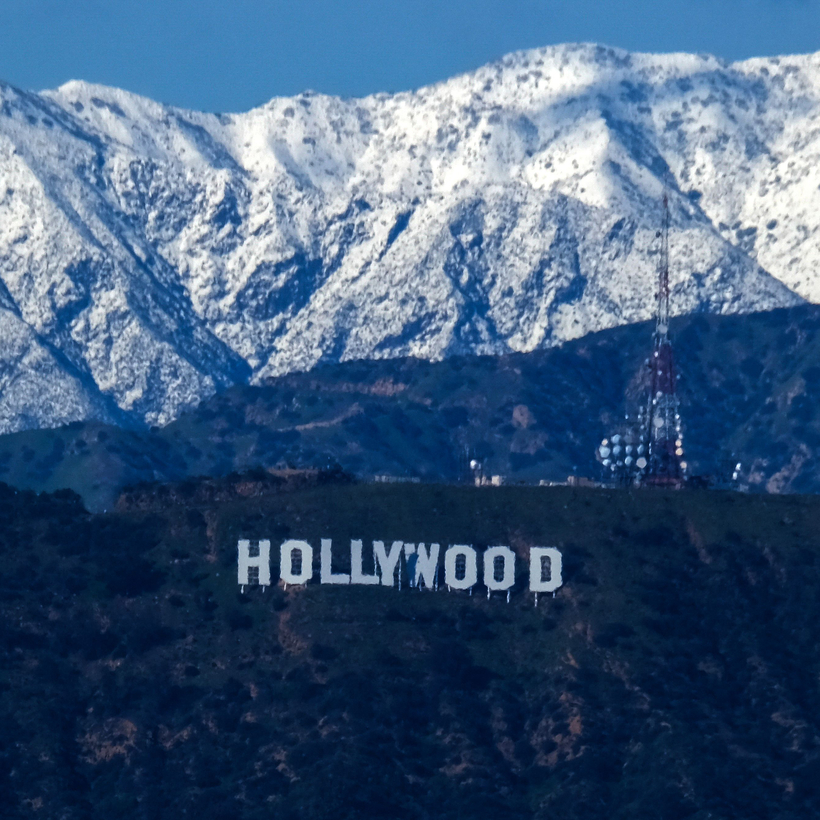For the past few weeks, Southern California has been under a barrage of extreme and unusual winter storms—storms whose volume, rapid succession, and bizarre outgrowths would seem out of place in New York City or Chicago, let alone in a region that has spent several years rationing water to withstand droughts.
In mid-January, days of “relentless rain” sent residents scrambling to avoid floods, mudslides, and debris. The Biden administration declared a state of emergency in California over what the Los Angeles Times reported could amount to the year’s first “billion-dollar disaster.”
Last week, Southern California residents were warned of another storm “of epic proportions,” causing the state to boost its water supply by 35 percent and issue the region’s first blizzard warning since 1989. There were reports of a “weak tornado” in Los Angeles, and in nearby San Bernardino, reports of something called “thundersnow,” which is more or less what it sounds like. Hundreds of thousands of residents lost power; during the past week, more than 127,000 outages were reported across the city of L.A.

There are few parts of Los Angeles that are better financially equipped to deal with this kind of natural disaster than Bel Air, the residential community where a fictional Will Smith stayed with the Banks family in the 90s, and where scores of nonfictional celebrities—Nick Offerman and Megan Mullally, Lakers forward Anthony Davis, Kathy Hilton, and both Jennifer Lopez and Jennifer Aniston—own multi-million-dollar mansions. But few demographics are less accustomed to surprise inconvenience than the ultra-affluent, and many denizens of Bel Air’s 3,000-odd properties have been rattled to find that weather doesn’t discriminate by tax bracket.
According to the Bel-Air Association, the area has had at least 13 power outages since the beginning of the year, plus an additional 2 or 3 that went unrecorded. Most of those outages were concentrated along Stone Canyon Road, a long, winding, exceedingly expensive strip that bisects the neighborhood, which one source likened to the “Park Avenue of Bel Air.” Last week, dozens of Stone Canyon residents lost power and Internet for four full days.

Some Stone Canyon residents have fled to hotels or second homes. Three sources say that even the Hotel Bel-Air, which is on Stone Canyon but, thanks to a back-up generator, doesn’t usually lose power during neighborhood outages, went dark last week. Without power, “they were not able to feed people in the main dining room,” says Fred Rosen, the former C.E.O. of Ticketmaster, who serves on the board of the neighborhood association. The Hotel Bel-Air declined to comment.
Many denizens of Bel Air’s 3,000-odd properties have been rattled to find that weather doesn’t discriminate by tax bracket.
Some have a sense of humor about the situation. “To me, it’s just kind of hilarious,” says resident Bel Air Alisha Shuford. “I’ve had to keep a lantern on standby—matches, headlamps—because it’s happened so frequently since January 1.”

Many less amused neighbors have taken a more active role in restoring their electricity—phoning local officials, wrangling in-laws with municipal connections, and filing what one local estimated was 300 complaints with the Los Angeles Department of Water and Power. The bulk of the Bel Air action has been organized in a 75-person WhatsApp group chat, where neighbors can share updates, plan outreach, and fret over topics such as the noise and traffic caused by Jay-Z’s pre-Grammys brunch, which was hosted on Stone Canyon.
According to Bel Air resident Carrie Calabria, neighbors have called the L.A.D.W.P. so many times that the department has taken to calling them “the Stone Canyon Club,” a nickname she finds “a little bit annoying.”
Power, cell service, Wi-Fi, and, for some, hot water have been unstable in the area. The town, founded by oil tycoon Alphonzo Bell in 1923, is celebrating its 100th anniversary this year, and her infrastructure does not look great for her age. Because of the mountainous topography, the majority of the neighborhood’s electrical gear is stored in underground vaults, a spokesperson for the L.A.D.W.P. explained. When it rains, those vaults are easily flooded, as the streets were designed for an arid climate. “We don’t even have gutters,” one resident explained.
“I’ve had to keep a lantern on standby.”
Flooded, century-old vaults tend to blow out—or, in one recent instance, start to steam, sending clouds of murky vapor up through the ground until a hazmat team could come fix it. But even in the non-gaseous cases, service crews still need to search for the source vault by vault, navigating the area’s narrow roads and myriad other underground utilities before starting repairs.
The system has been put under strain as the size of the area’s estates have ballooned. “When the infrastructure in this community was put in, homes were 2,500 feet, 3,000 feet, 4,000 feet,” says Rosen. “Now you have homes that are 10,000 feet, 20,000 feet, 30,000 feet, 40,000 feet, but the power grid didn’t get bigger.”

“When we lose power for [an] extensive period of time we also lose internet which impedes the ability to work remote,” one neighbor wrote in the WhatsApp group. “Financial hardship!”
With no clear solution for the flooded vaults, one neighbor suggested, “it’s up to us to protect us.”
On Wednesday evening, Bel Air residents were invited by the L.A.D.W.P. to a private webinar on the particular issues plaguing their pipes—a nearly two-hour ordeal. The officials apologized some dozen times for the inundation of local complaints they had received. But their remorse wasn’t entirely well-received. “I thought the webinar was a total joke,” says Calabria. “It was nothing but excuses and pictures of fallen trees.”
When an L.A.D.W.P. representative urged the crowd to keep calling in power lapses, a woman wrote in the Zoom chat: “Did she not hear that we don’t have phones during these outages?”
Tarpley Hitt is a freelance reporter and an editor for The Drift

